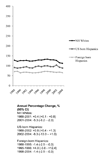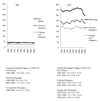Breast cancer incidence patterns among California Hispanic women: differences by nativity and residence in an enclave
- PMID: 20447917
- PMCID: PMC2895619
- DOI: 10.1158/1055-9965.EPI-10-0021
Breast cancer incidence patterns among California Hispanic women: differences by nativity and residence in an enclave
Abstract
Background: Breast cancer incidence is higher in U.S.-born Hispanic women than foreign-born Hispanics, but no studies have examined how these rates have changed over time. To better inform cancer control efforts, we examined incidence trends by nativity and incidence patterns by neighborhood socioeconomic status (SES) and Hispanic enclave (neighborhoods with high proportions of Hispanics or Hispanic immigrants).
Methods: Information about all Hispanic women diagnosed with invasive breast cancer between 1988 and 2004 was obtained from the California Cancer Registry. Nativity was imputed from Social Security number for the 27% of cases with missing birthplace information. Neighborhood variables were developed from Census data.
Results: From 1988 to 2004, incidence rates for U.S.-born Hispanics were parallel but lower than those of non-Hispanic whites, showing an annual 6% decline from 2002 to 2004. Foreign-born Hispanics had an annual 4% increase in incidence rates from 1995 to 1998 and a 1.4% decline thereafter. Rates were 38% higher for U.S.- than foreign-born Hispanics, with elevations more pronounced for localized than regional/distant disease, and for women>50 years of age. Residence in higher SES and lower Hispanic enclave neighborhoods were independently associated with higher incidence, with Hispanic enclave having a stronger association than SES.
Conclusions: Compared with foreign-born, U.S.-born Hispanic women in California had higher prevalence of breast cancer risk factors, suggesting that incidence patterns largely reflect these differences in risk factors.
Impact: Further research is needed to separate the effects of individual- and neighborhood-level factors that affect incidence in this large and growing population.
Copyright (c) 2010 AACR
Figures


Similar articles
-
Gastric cancer incidence among Hispanics in California: patterns by time, nativity, and neighborhood characteristics.Cancer Epidemiol Biomarkers Prev. 2012 May;21(5):709-19. doi: 10.1158/1055-9965.EPI-11-1208. Epub 2012 Feb 28. Cancer Epidemiol Biomarkers Prev. 2012. PMID: 22374991 Free PMC article. Clinical Trial.
-
Immigration factors and prostate cancer survival among Hispanic men in California: does neighborhood matter?Cancer. 2014 May 1;120(9):1401-8. doi: 10.1002/cncr.28587. Epub 2014 Jan 29. Cancer. 2014. PMID: 24477988 Free PMC article.
-
The influence of nativity and neighborhoods on breast cancer stage at diagnosis and survival among California Hispanic women.BMC Cancer. 2010 Nov 4;10:603. doi: 10.1186/1471-2407-10-603. BMC Cancer. 2010. PMID: 21050464 Free PMC article.
-
Disparities in liver cancer incidence by nativity, acculturation, and socioeconomic status in California Hispanics and Asians.Cancer Epidemiol Biomarkers Prev. 2010 Dec;19(12):3106-18. doi: 10.1158/1055-9965.EPI-10-0863. Epub 2010 Oct 12. Cancer Epidemiol Biomarkers Prev. 2010. PMID: 20940276 Free PMC article.
-
Hispanic and Immigrant Paradoxes in U.S. Breast Cancer Mortality: Impact of Neighborhood Poverty and Hispanic Density.Int J Environ Res Public Health. 2016 Dec 14;13(12):1238. doi: 10.3390/ijerph13121238. Int J Environ Res Public Health. 2016. PMID: 27983668 Free PMC article.
Cited by
-
Oncotype DX Test Receipt among Latina/Hispanic Women with Early Invasive Breast Cancer in New Jersey: A Registry-Based Study.Int J Environ Res Public Health. 2021 May 12;18(10):5116. doi: 10.3390/ijerph18105116. Int J Environ Res Public Health. 2021. PMID: 34065945 Free PMC article.
-
Investigating disparities: the effect of social environment on pancreatic cancer survival in metastatic patients.J Gastrointest Oncol. 2020 Aug;11(4):633-643. doi: 10.21037/jgo-20-39. J Gastrointest Oncol. 2020. PMID: 32953147 Free PMC article.
-
Cancer Mortality Patterns by Birthplace and Generation Status of Mexican Latinos: The Multiethnic Cohort.J Natl Cancer Inst. 2022 Jul 11;114(7):959-968. doi: 10.1093/jnci/djac078. J Natl Cancer Inst. 2022. PMID: 35404450 Free PMC article.
-
How do social factors explain outcomes in non-small-cell lung cancer among Hispanics in California? Explaining the Hispanic paradox.J Clin Oncol. 2013 Oct 1;31(28):3572-8. doi: 10.1200/JCO.2012.48.6217. Epub 2013 Aug 19. J Clin Oncol. 2013. PMID: 23960183 Free PMC article.
-
Impact of socioeconomic status and ethnic enclave on cervical cancer incidence among Hispanics and Asians in California.Gynecol Oncol. 2014 Jun;133(3):409-15. doi: 10.1016/j.ygyno.2014.03.559. Epub 2014 Mar 24. Gynecol Oncol. 2014. PMID: 24674831 Free PMC article.
References
-
- Guzman B. Census 2000 Brief. Washington, DC: US Department of Commerce, Economics and Statistics Administration, US Census Bureau; 2001. The Hispanic Population: 2000.
-
- Malone N, Baluja KF, Costanzo JM, Davis CJ. Census 2000 Brief. Washington, DC: US Department of Commerce, Economics and Statistics Administration, US Census Bureau; 2003. The Foreign-Born Population: 2000.
-
- O'Brien K, Cokkinides V, Jemal A, et al. Cancer statistics for Hispanics, 2003. CA Cancer J Clin. 2003;53:208–226. - PubMed
-
- Horner M, Ries L, Krapcho M, et al. SEER Cancer Statistics Review, 1975–2006. Bethesda, MD: National Cancer Institute; 2009.
-
- Eidson M, Becker TM, Wiggins CL, Key CR, Samet JM. Breast Cancer among Hispanics, American Indians and Non-Hispanic Whites in New Mexico. Int J Epidemiol. 1994;23:231–237. - PubMed
Publication types
MeSH terms
Grants and funding
LinkOut - more resources
Full Text Sources
Medical

